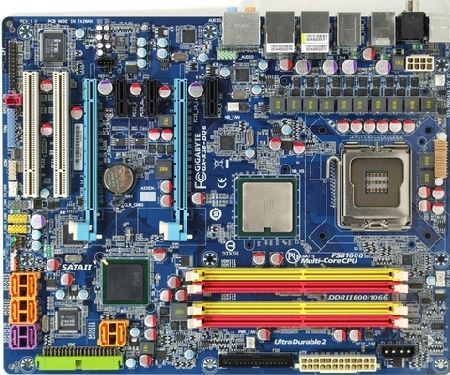Intel X38 Chipset: A Porsche with the Handbrake On
Conclusion: X38 Boards Too Expensive; P35 Offers More Bang For The Buck
Intel's new X38 chipset brings two new features to the table. However, there are no graphics cards yet for the PCI Express 2.0 interface, and no modules to make use of the XMP memory feature. Which brings us to another problem, namely DDR3 memory modules in general. While the board supports DDR3 memory, the prices for the modules are so high as to be practically impossible to sell them. It is no great surprise, then, that motherboard makers have decided to offer only products that support DDR2 for the time being. Bear in mind that these boards can't be upgraded for use with DDR3 memory later - X38 DDR2 boards will thus never be able to unlock their full potential!
The current situation is like a Gordian Knot: you can't say that Intel hasn't done its homework, since the X38 definitely includes some forward-looking features. Yet you also cannot blame the motherboard makers for only designing X38 boards that work with the cheaper DDR2 memory modules instead of the frighteningly expensive DDR3 variety. The price of DDR3 memory must first come down before motherboards with DDR3 support will appear, and then, finally, the user will be able to really benefit from the X38 design. Compare Prices on X38 Motherboards
Time and patience seem to be the only solution to this situation. The same goes for the overclocking capabilities of the X38 chipset, by the way. At any rate, we hadn't heard of a working overclocking by press time.
Although Intel takes a step in the right direction by implementing support for overclocking features directly in software, the results so far fail to impress. The maximum clock speed of the North Bridge is not on par with that of the previous chipset, the 965P. Intel needs to work on putting its overclocking software on a firmer hardware basis.
Intel's two PCI Express x16 slots will only will only elate fans of AMD/ATI's Crossfire technology, since there is no support for Nvidia's SLI. The upshot: dual-graphics solutions are only available to "half the world".
Bottom line: the first boards that are listed in the shops are simply too expensive and offer features that users will not be able to fully take advantage of today. This makes P35-based boards look a lot more attractive. Our recommendation is that potential buyers hold on to their money before buying an X38 board, and wait until the features it offers are properly supported.
Join our discussion on this topic
Get Tom's Hardware's best news and in-depth reviews, straight to your inbox.
Current page: Conclusion: X38 Boards Too Expensive; P35 Offers More Bang For The Buck
Prev Page Synthetics, ContinuedTom's Hardware is the leading destination for hardcore computer enthusiasts. We cover everything from processors to 3D printers, single-board computers, SSDs and high-end gaming rigs, empowering readers to make the most of the tech they love, keep up on the latest developments and buy the right gear. Our staff has more than 100 years of combined experience covering news, solving tech problems and reviewing components and systems.

